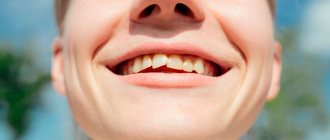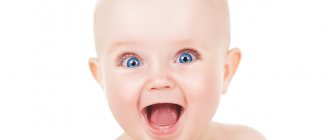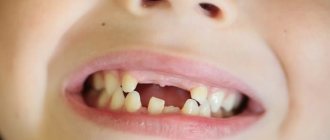Approximate timing of baby teeth eruption
On average, the first tooth appears at 6-7 months, but sometimes this joyful event occurs earlier - at 4-5 months, or, on the contrary, is delayed. The reason for this, as a rule, is heredity. Therefore, you should not unconditionally rely on generally accepted charts: everything is individual.
In general, the monthly scheme looks like this:
- 6-7 months - most babies have 2 lower incisors in the center;
- 8-9 months – by this age you can expect 2 upper incisors;
- 9-11 months – by almost a year, 2 lateral incisors are visible from above;
- 12-13 months - during this period there are also 2 lateral incisors from below.
So, to the question of how many baby teeth a child should have by the age of one year, we can safely answer: 8.
Timing of eruption of permanent teeth in children
Hurry up! Before the start of the summer holidays, there is a unique opportunity to take advantage of a 15% discount on pediatric dentistry!
Interactive dental formula
The timing of teething can characterize both the biological and passport age of the child. The process and timing of teething depend not only on inherited genetic parameters. The timing of teething can be influenced by external and internal factors (climatic conditions, diet, quality of drinking water, etc.). In this regard, the timing of the eruption of permanent teeth varies in different regions.
During a person’s life, 20 teeth change once, and the remaining 8-12 teeth do not change; they erupt initially as permanent teeth (molars).
By the age of three, all baby teeth erupt in a child, which by the age of 5 begin to gradually be replaced by permanent ones.
There are 20 primary teeth in total: on each jaw there are 4 incisors (4 central teeth), 2 canines (third teeth) and 4 molars (fourth and fifth teeth).
An adult normally has 28-32 permanent teeth: each jaw has 4 incisors, 2 canines, 4 premolars and 4-6 molars. The development of the third molar (“wisdom tooth”) may not occur at all (with congenital edentia of the third molars), which is also considered normal. Another situation is also possible: a wisdom tooth is embedded in the thickness of the jaw, but never erupts (due to incorrect position or lack of space in the jaw). This situation occurs very often.
After all the baby teeth have erupted, there are no gaps (gaps, gaps) between them, which is normal. But as the jaw grows, before the baby teeth are replaced by permanent ones, gaps should appear between the baby teeth. This process is necessary because permanent teeth are larger in size than baby teeth and if spaces are not formed, then the permanent teeth do not fit in the jaws and the child receives “crooked” permanent teeth.
In parallel with the formation of spaces between temporary teeth, the roots of baby teeth are “reabsorbed”, after which the teeth alternately become loose and fall out.
There is no general opinion about the normal timing of the eruption of permanent teeth, since scientific studies by different authors were carried out in different regions and in different years of the last and present centuries. Here are the norms for the eruption of permanent teeth according to several authors:
Central incisors 5-6 years (Vinogradova T.S. 1982) 6-8 years (Kolesov A.A. 1985) 7-8 years (Magid E.A. et al. 1987, Bykov V.L. 1998) 6- 9 years (Kalvelis D.A. 1994)
Lateral incisors 7-9 years (Vinogradova T.S. 1982) 8-9 years (Kolesov A.A. 1985, Magid E.A. et al. 1987, Bykov V.L. 1998) 7-10 years (Kalvelis D .A. 1994)
Fangs 12-13 years (Vinogradova T.S. 1982, Bykov V.L. 1998) 9-11 years (Kolesov A.A.1985) 10-13 years (Magid E.A. et al. 1987) 9-14 years (Kalvelis D.A. 1994)
First premolars 9-11 years (Vinogradova T.S. 1982, Bykov V.L. 1998) 9-10 years (Kolesov A.A. 1985, Magid E.A. et al. 1987) 9-13 years (Kalvelis D .A. 1994)
Second premolars 9-11 years (Vinogradova T.S. 1982) 11-12 years (Kolesov A.A. 1985, Magid E.A. et al. 1987, Bykov V.L. 1998) 10-14 years (Kalvelis D .A. 1994)
First molars 4.5 -7 years (Vinogradova T.S. 1982) 6 years (Kolesov A.A.1985) 5-6 years (Magid E.A. et al. 1987) 5-8 years (Kalvelis D.A. . 1994) 6-7 years (Bykov V.L. 1998)
Second molars 12-13 years (Vinogradova T.S. 1982, Kolesov A.A. 1985, Magid E.A. et al. 1987, Bykov V.L. 1998) 11-14 years (Kalvelis D.A. 1994)
Third molars (“wisdom teeth”) 18-25 years (Magid E.A. et al. 1987) 18-20 years (Kalvelis D.A. 1994) 18-30 years (Bykov V.L. 1998)
Here is the most common sequence of eruption of permanent teeth:
- First molars ("sixth teeth")
- Central incisors
- Lateral incisors
- First premolars ("fourth teeth")
- Canines (“eye teeth”) and/or second premolars (“fifth teeth”)
- Second molars ("seventh teeth")
- Third molars ("wisdom teeth")
Important! Each baby tooth is normally loosened and replaced with a permanent one.
Central primary incisor on the permanent one of the same name
Lateral primary incisor on the permanent one of the same name
Milk canine to permanent canine of the same name
First primary molar to first permanent premolar ("fourth tooth")
Second primary molar to second permanent premolar ("fifth tooth")
First permanent molar ("sixth tooth")
appears immediately permanent at 5-7 years.
Second permanent molar ("seventh tooth")
appears immediately permanent at 9-12 years of age.
Therefore, even if your child has not lost a single milk tooth at the age of 5-7 years, this does not mean that he does not have permanent molars (“sixth teeth”). The appearance of these teeth is not always accompanied by fever and general malaise.
Also, do not despair and panic if a child aged 5-7 years has a fever and is not eating well, perhaps his first molars are cutting!
A.I. Rarely dentist
2013
After a year, teeth appear with the following frequency:
- by 12-15 months – two pairs of first molars erupt;
- by 18-20 months – a pair of upper and a pair of lower canines are already clearly visible;
- 20-30 months is the period of appearance of two pairs of second molars.
How many teeth should a child have at 1 year 3 months? Ideally 12, but the number can change in one direction or the other, and this is not considered a deviation. The frequency of teething is influenced by many factors, including previous infections, heredity, climate, and health status.
The question of how many teeth a child should have at 1 year 8 months, or 20 months, also cannot be answered unambiguously. The answer will be approximate - about 16. Up to a year, parents should focus on the approximate formula: the number of months minus 4, with a reservation for the baby’s characteristics.
Teeth of 4 year old children. The importance of caring for baby teeth
How many teeth should a child have at 4 years old? By the age of 4, almost all children have a full set of baby teeth - 20 pieces (maybe only 16 - this is individual, and this is the norm). The child actively uses them - bites, chews. That is, teeth are constantly in an aggressive environment and are subject to mechanical stress, including abrasion. In the article “Baby teeth in children - norm, features, purpose,” we talked in detail about the structure of children’s teeth.
In particular, the fact that the enamel coating of baby teeth is much thinner than that of permanent teeth, that it is more permeable, and the pulp occupies most of the volume of the tooth. For this reason, the first teeth are more susceptible to caries, and carious cavities reach the pulp faster. In an adult, before the onset of inflammation of the pulp - pulpitis, caries develops for a year, or even several years. Six months or a little more is enough for children's teeth. Especially if the child does not receive adequate nutrition or has a metabolic disorder. This is where caring for baby teeth comes to the fore.
Treatment and care of baby teeth
Many parents have a big misconception - baby teeth are temporary, which means it is not necessary to take care of them, there is no need to treat them, they say, they will fall out anyway. This is fundamentally wrong - a baby’s teeth are vitally important, and that’s exactly what they are at this time. This is how a child’s body works. And the absence or inadequate functioning of baby teeth can lead to irreparable losses in later life. Untreated baby teeth can lead to both local problems, the most difficult of which is damage or even dissolution of the permanent tooth germ, and general problems: diseases of the gastrointestinal tract, problems with the adenoids, chronic runny nose and tonsillitis, etc. Treatment Primary teeth treatment in children is no less important than the treatment of permanent teeth. Untimely removal of a baby tooth leads to the shifting of other teeth, which means abnormal development of the jaw. The location of the rudiments of permanent teeth automatically shifts, which will grow very closely in one place, and in others there will be large, unaesthetic gaps.
The earlier the baby loses a baby tooth, the more noticeable the consequences will be. For example, if a child soon loses chewing teeth (before 5-6 years), then the correct growth of the jaws is disrupted, and even facial features change, especially in the lower part. If caries of baby teeth has begun, timely treatment is the most important factor in the full development of permanent teeth (“What is the danger of premature removal of baby teeth”). Sucking on a pacifier, feeding from a bottle, and even breastfeeding after the age of 2 years also have a very unfavorable effect on baby teeth. It is for this reason that we constantly draw the attention of adults - take care of your children’s early teeth, because this is their ticket to a healthy, fulfilling life.
How many teeth should a child have at 3 years old?
All twenty baby teeth appear by about 2-2.5 years. It includes eight incisors and molars, as well as four canines. By this time, they are erupting, including in the wrong direction, but by the age of three, in most cases they occupy a normal position, since the child is actively chewing food.
If by the age of three a boy or girl does not have a full set, do not panic. This may be an individual characteristic of the child. To be sure, it is advisable to consult a pediatrician and dentist to clarify the cause of the delay and rule out rickets, metabolic disorders or endocrine diseases.
Permissible deviations from the schedule
Signs of the imminent appearance of the first teeth are drooling, swollen gums, and fever. It is important to monitor the child’s well-being during this period.
READ ALSO: How can you lower your temperature if you are teething?
As noted above, at six months the baby already has his first teeth. A shift of one to three months later than normal indicates rickets or an infectious disease. Also the cause is illnesses that the woman suffered during the period of gestation.
On the contrary, the early appearance of teeth is a symptom of unstable functioning of the endocrine system. The absence of teeth up to a year is rarely associated with edentia, that is, with the absence of rudiments. This can be checked in the pediatric dentist's office.
Should I contact a pediatric dentist?
If a child’s teeth grow without pain or inflammation, it is enough to go for regular preventive examinations every six months.
You need to make an appointment at the dental clinic when:
- molars do not grow longer than 5 months. You may need orthodontic treatment to correct your bite.
- the indigenous ones began to grow, but the dairy ones still remained. To form a correct bite, temporary teeth must be removed.
- a baby tooth fell out due to injury. Neighboring teeth can take up empty space and the molar has nowhere to grow.
- The child grinds his teeth a lot at night. Because of this, the enamel is damaged, so the dentist prescribes special mouth guards that are put on the teeth before going to bed.
- Be sure to consult a doctor at the first signs of caries. The process quickly goes deep into the baby tooth, and can move on to the rudiments of the molars.
Remember: timely prevention of oral diseases means correct bite and a beautiful smile. Therefore, you need to take care of your teeth from childhood.
Schedule for changing baby teeth to permanent teeth.
Primary teeth are a set of 20 primary teeth. Typically, replacing them with permanent teeth looks like this:
- 6 – 8 years – upper and lower incisors (units)
- 7 – 9 years – upper and lower lateral incisors (twos)
- 8 – 12 years – fangs (threes)
- 10 – 13 years – first and second premolars (fours and fives)
Baby teeth differ from “adult teeth” not only in size, but also in structure: their enamel is about 2 times thinner and not so saturated with minerals. Therefore, adults need to control that the child brushes his teeth thoroughly - caries on baby teeth develops quickly and quickly develops into pulpitis.
Memo to parents
☑️ An empty hole should not bleed much. If the capillaries are damaged, it is enough to apply a sterile swab until the bleeding stops. Set aside lunch for 1-2 hours. You can drink unsweetened liquids, preferably water.
☑️ There is no need to smear the wound with antiseptics or rinse your mouth - the blood clot covering the hole will be washed away.
☑️ The bleeding does not stop for more than 10 minutes - consult a doctor.
☑️ To strengthen the roots of new teeth, you need to load your jaws. Give your child more fruits and vegetables to chew on: apples, young carrots.
☑️ Calcium is necessary for growing teeth. Dairy products are rich in it, especially hard cheese, cottage cheese and kefir. There is a lot of calcium in greens and legumes; to “get” it from foods, add 10-20 grams of fat to the dish.
Children can have candy! The main rule for preventing caries in children during tooth growth is that there should be no sugar or food particles left in the mouth.
Candy is tasty and safe if you brush your teeth or rinse your mouth with clean water after dessert.











